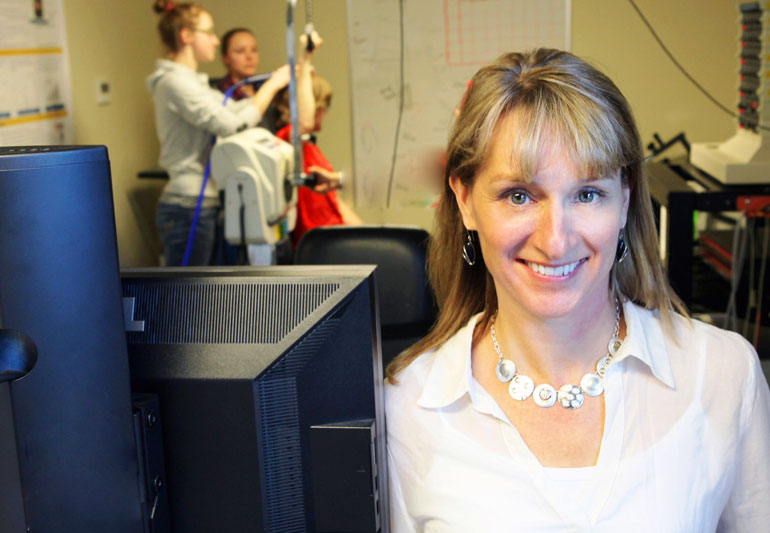
Jennifer Jakobi, associate professor in the School of Health and Exercise Sciences
Parents can take advantage of programs and initiatives to promote science, engineering and math
Parents are increasingly looking for ways to promote an interest in science, technology, engineering and math (STEM) to their children, especially as access to traditional learning environments has been made more challenging.
For UBC Okanagan Professor Jennifer Jakobi, exposing young people in the Okanagan to the STEM fields is critical as COVID-19 changes the way students and parents think about education. She says the university is in a unique position to help bring knowledge and resources to the community.
Jakobi is a researcher in UBC Okanagan’s School of Health and Exercise Sciences. She leads the integrative STEM Team Advancing Networks of Diversity (iSTAND) program and is the associate chair of Westcoast Women in Engineering, Science and Technology (WWEST) where she is working to improve participation of women and other underrepresented groups in STEM.
Why is it important to introduce STEM to children at an early age?
To inspire and motivate at an early age. One reason why young teens, especially girls, do not pursue STEM—or worse yet indicate a dislike for the sciences—is a lack of connection. Children need to understand that science is not an equation or fact, it is real and part of their everyday life. Do this early and in a fun way and it blossoms—it might even withstand the test of teenage years, where friends and ‘fitting-in’, which is typically not associated with liking science, are challenged daily.
The passion needs to be greater than the societal pressure to be cool, and a starting point for this can be an understanding that STEM exists in every aspect of life. This needs to start early for a genuine appreciation.
What challenges does COVID-19 present in making STEM more accessible for youth?
Schools are different now, even compared to last year. Resources for extracurricular activities are challenged by the health, safety and physical distancing regulations. Children are generally getting less hands-on opportunities, fewer class trips and visitors into the school and classroom. This minimizes the STEM school experience. Couple that with the rising cost of fee-for-service activities outside school, because registration numbers are limited for COVID-19 health and safety, the opportunity to experience diverse STEM activities have become limited. Financial barriers are real and growing for many families. Thus, teachers and parents alike are facing greater challenges in exposing students to STEM in the current climate of a pandemic.
Are there any programs or initiatives at UBCO or in the community that might help parents and students better engage with STEM?
Kelowna and the surrounding area have amazing community resources, for example the Okanagan Science Centre. There are also programs and services offered through UBC Okanagan. For instance, the STEM UBCO group includes individual faculty members that conduct specialized outreach in areas like chemistry or computer science, and formalized programs on campus actively engaged in classroom and community outreach events. The iSTAND program, developed at UBC Okanagan, GeeringUp Vancouver and Let’s Talk Science have divisions in Kelowna that are actively leading hands-on STEM experiences in the community, schools, on campus and now online. The response to online programming is refreshing. Across generations, there is family learning and activities underway that are enabling intergenerational understanding of the evolution of STEM and how these fields are part of our everyday life—from sport to toothpaste.
How can parents without a STEM background help their children engage with these subjects?
Parents without STEM backgrounds are great teachers. They get to explore and learn alongside their kids. The best type of interactions and learning happens when parents discover, encourage and support actively with their children. Including grandparents and other caregivers creates greater opportunity to strengthen awareness and understanding. The best learning starts with questions. After that, there are numerous programs, and now online resources for all generations.
What can young, aspiring scientists and engineers do to build on their interest?
Ask questions, don’t be bashful. Explore local science centres, farms, libraries and the university, including attending STEM camps. While COVID-19 restrictions mean that in-person visits may not be possible, many of these programs have shifted online and have created innovative resources for engaging at home or while physically distanced. Teens should consider volunteering in STEM programs at UBCO or in the community. There are also a number of showcases and competitions that have created online programming for youth and teens. For example, opportunities such as the Youth Innovation Showcase and Science Fairs are available to be recognized for interest, innovation, and to meet other youth and teens with similar interests.
About UBC’s Okanagan campus
UBC’s Okanagan campus is an innovative hub for research and learning founded in 2005 in partnership with local Indigenous peoples, the Syilx Okanagan Nation, in whose territory the campus resides. As part of UBC—ranked among the world’s top 20 public universities—the Okanagan campus combines a globally recognized UBC education with a tight-knit and entrepreneurial community that welcomes students and faculty from around the world in British Columbia’s stunning Okanagan Valley.
To find out more, visit: ok.ubc.ca